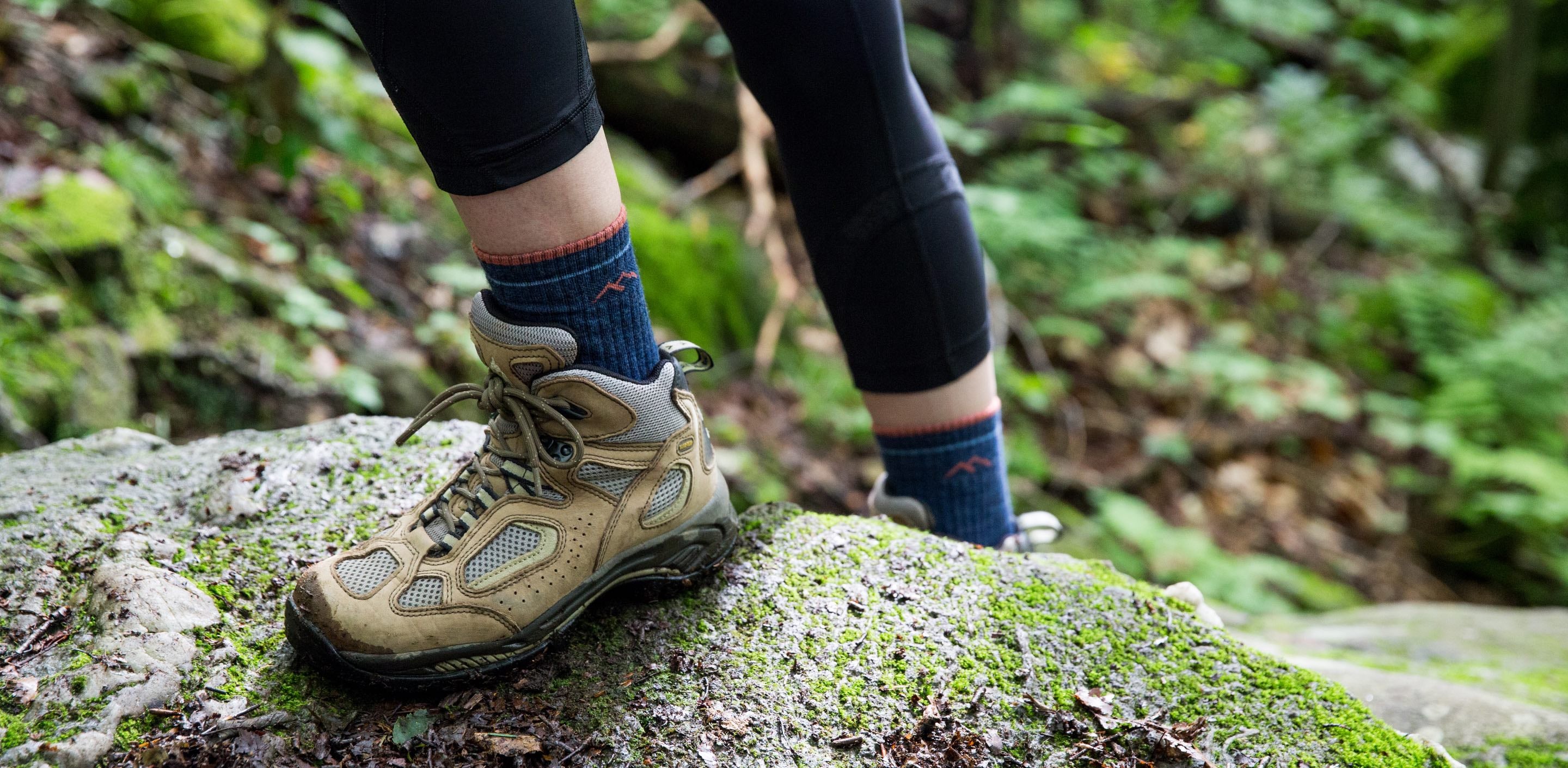Why You Shouldn't Wear Cotton Socks

Dramatics aren’t really our thing, but the whole “cotton kills” issue is something we feel deserves some special attention when it comes to comparing sock materials.
Now this isn’t an attack ad against cotton, everything has its time and place. This is more an informative piece, informing you that when it comes to what you should wear on your body while being active indoors or outdoors, it’s neither cotton’s time nor place.
Dressing for the Elements
A peek outside your window will determine if you’re gonna grab shorts or leggings for your run, an extra base layer for your hike, or a jacket on your way to the office. You dress for the elements and depend on your clothing to help you stay dry, either cool or warm, and just plain comfortable.
But what you don’t need the clouds to tell you is, whatever outfit you’re piecing together, for whatever activity you’re gearing up for, the material on the label should not read cotton. It has everything to do with cotton’s relationship with water.
Cotton and Water
Whether or not it’s raining or snowing, humid or damp, you are probably going to sweat. Anytime you’re active, your body is essentially creating water. This accumulation of moisture is why what you wear matters.
If you’re opting for a base layer that is cotton, you should know that cotton absorbs significantly more water than any other fabric. To put it in perspective, cotton absorbs up to 2700% of its weight in moisture.

When cotton fabrics become wet, they lose their ability to insulate. Dry fabric insulates you by trapping air against your skin and creating a pocket of warm air versus wet fabric which moves heat away from your body faster than cold air alone will.
Why is this a problem? Cotton’s inability to stay dry compared to other fabrics can leave the wearer at risk for hypothermia, hence the infamous slogan, “cotton kills.”
Cotton and Hypothermia
So, when does wearing cotton become dangerous? Whenever you happen to work up a sweat. Say when you’re out on the trail, in the middle of winter, wearing cotton.
Even though it’s cold out, you’re still going to sweat as you hike. That cotton is going to soak up that sweat and hold on to it. You may not notice this at first because you’re warm due to the energy you’re exerting. But what happens when you take a break for a snack? Or reach the top of the mountain and take in the view? Your body starts to cool down naturally. And now your sweat-soaked, wet base layer, is sticking to your skin, pulling heat away from your body.
So not only are the elements going to start bringing down your core temperature, but now the material your wearing is also working against you. Suddenly, that sweat you worked up has become cold against your body, and you become all too aware of the winter chill. If your temperature drops too low, your heart could stop. Again, not to be dramatic.

We called out winter simply to paint a picture, but that doesn’t mean the risk of hypothermia only presents itself during the cold weather months. If left unprepared, hikers and others are at risk of hypothermia in the warmer months as well. This is where Merino Wool comes into play.
Wick-It
It’s clear we don’t want wet clothes, but without removing sweat glands or dodging precipitation, the only solution is to change what we wear. Cotton absorbs moisture, making it the wrong choice, but Merino Wool fabric’s natural benefits make it the right one.
Where cotton traps moisture, Merino Wool wicks it. Wool absorbs the moisture, spreads it across a larger surface, and dissipates it gradually, allowing it to evaporate. Merino Wool's natural fibers can absorb up to 30% of their own weight in water before feeling wet — and unlike cotton fibers, Merino continues to insulate when wet.
When you’re wearing Merino Wool as a base layer, moisture isn’t trapped next to your skin, it’s actively moved away from your skin. You remain drier overall and dry off faster if you do get wet—essential for keeping warm in cold weather.

At Darn Tough, we knit our socks with this Merino Wool for many reasons, one being its ability to wick away moisture and keep you drier. This is helpful in the cold but also whenever you are in contact with moisture or sweat.
Take exercise for example. Just as it keeps you warm, Merino Wool will keep you cool and your feet dry during intense exercise or heat. It will act as a buffer against humidity, absorbing the hot moisture and wicking it away from your skin to keep you cool.
We also knit some socks with Coolmax® and Thermolite® materials because of their ability to wick away moisture and their breathability. While Merino Wool socks are the best, these two synthetic materials still beat cotton.
Merino Wool vs. Cotton Socks: Round 1
We only led with “Cotton Kills” because we needed a hook… and we want to keep you safe out there. But it was all a lead up for the main reason you need to ditch cotton, especially in your socks, and convert your sock drawer to Merino Wool. That reason being blisters.
Though Merino Wool is a great choice for any base layer, this is how it relates to your feet. We prepped you with the whole cotton and moisture absorption part, remember?
Your feet get sweaty, no sense denying it. When they do, it’s Merino Wool socks that you’re gonna want to grab. During exercise, running, hiking, other outdoor activities, or yeah, just walking to the office, your feet will sweat or even get wet (remember – dress for the elements). Cotton absorbs water, which creates friction—and, in short, painful blisters.

Ever tried to hike in wet socks or run in sweat-drenched cotton? You’ve probably ended up with blisters that have you calling it quits before you even have time to reach for the trail mix and instead googling, “Are you supposed to pop blisters?”
Your feet need the wool fibers to draw moisture away and encourage evaporation. Dry feet are less prone to blisters. Merino Wool socks will keep you comfortable and, on your feet, leaving you searching for a different excuse to stop.
Knockout
We’ve got keeping you alive and keeping you blister free as two reasons to wear wool socks over cotton socks. And while usually we don’t like to brag, we just want to finish this off with some other reasons why Merino Wool reigns supreme vs other sock materials.
- Clothing made with Merino Wool last longer. You might have heard us ramble on about our socks’ durability once or twice. Well, you have Merino Wool to thank.
- You also won’t stink after you sweat. That may be reason alone to invest.
- You can go longer between wash cycles. Wool is naturally odor-resistant, so each pair of socks can take multiple wears.
- It is a magic fabric with insulating properties that keeps you cool when hot out, warm when cool out.
- And once more, for the people in the back, it will help you fight hypothermia.
TL;DR
Are wool socks better than cotton?
Wool socks are better than cotton because they naturally wick moisture and regulate body temperature. Unlike 100% cotton socks, Merino Wool is one of nature’s best insulators, helping keep feet dry even after they get wet.
Are wool socks warmer than cotton?
Not only are wool socks warmer than cotton in cold weather, but they also keep your feet cool in warm weather. Knit from high quality Merino Wool, Darn Tough socks naturally insulate against the cold and keep feet comfortable in any weather condition.
Should you wear cotton socks under wool socks?
We don’t recommend wearing anything under our wool socks – but especially not cotton. Sourced from some of the world’s most resilient Merino sheep, Darn Tough socks are intended to sit against your skin for best results during activity.
Are wool or cotton socks better for winter?
Merino Wool socks are the gold standard for protecting your feet during winter. When temperatures drop below zero, Merino’s naturally moisture wicking properties ensure your feet stay dry and warm no matter how cold it gets.
Why are cotton socks bad?
Cotton socks are bad for your feet because they absorb significantly more water than any other fabric – namely Merino Wool. Cotton absorbs up to 2700% of its weight in moisture, leaving wearers at risk for hypothermia and blisters if their socks get wet.
Why is cotton bad for hiking?
Compared to Merino Wool, cotton garments deliver inferior performance and can even be dangerous to wear in the elements. When cotton fabrics become wet, they lose their ability to insulate, leaving your feet susceptible to hypothermia.







